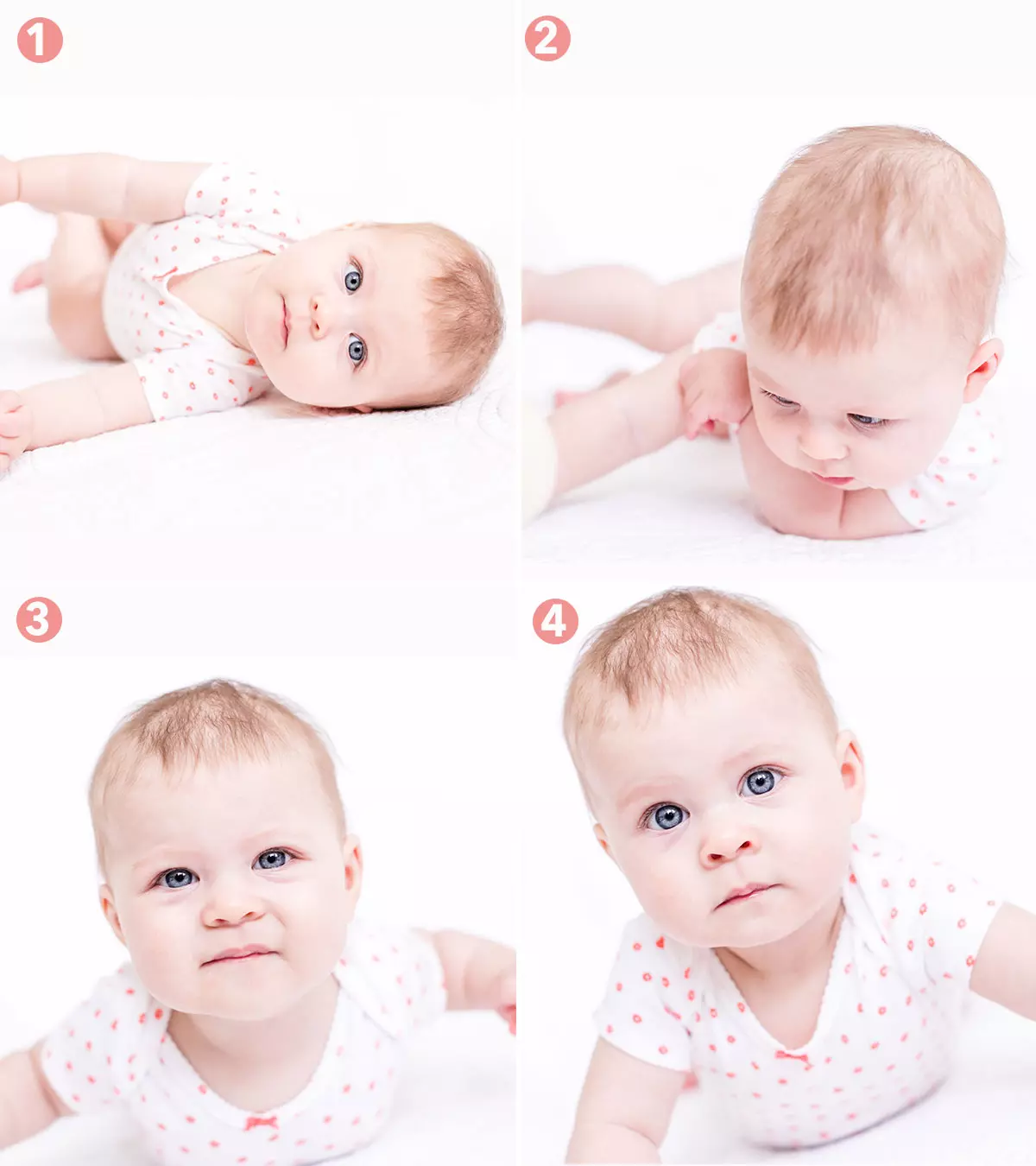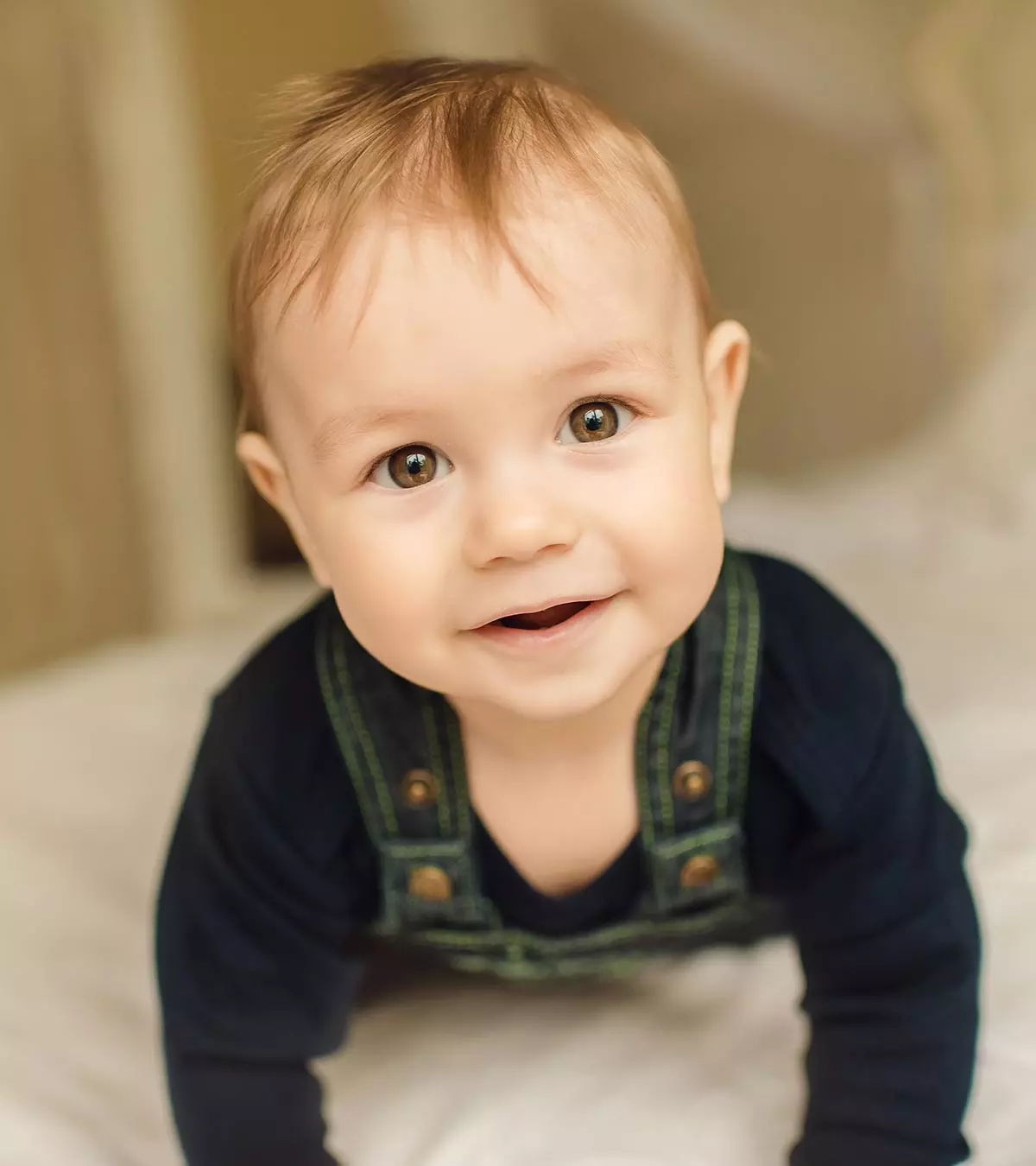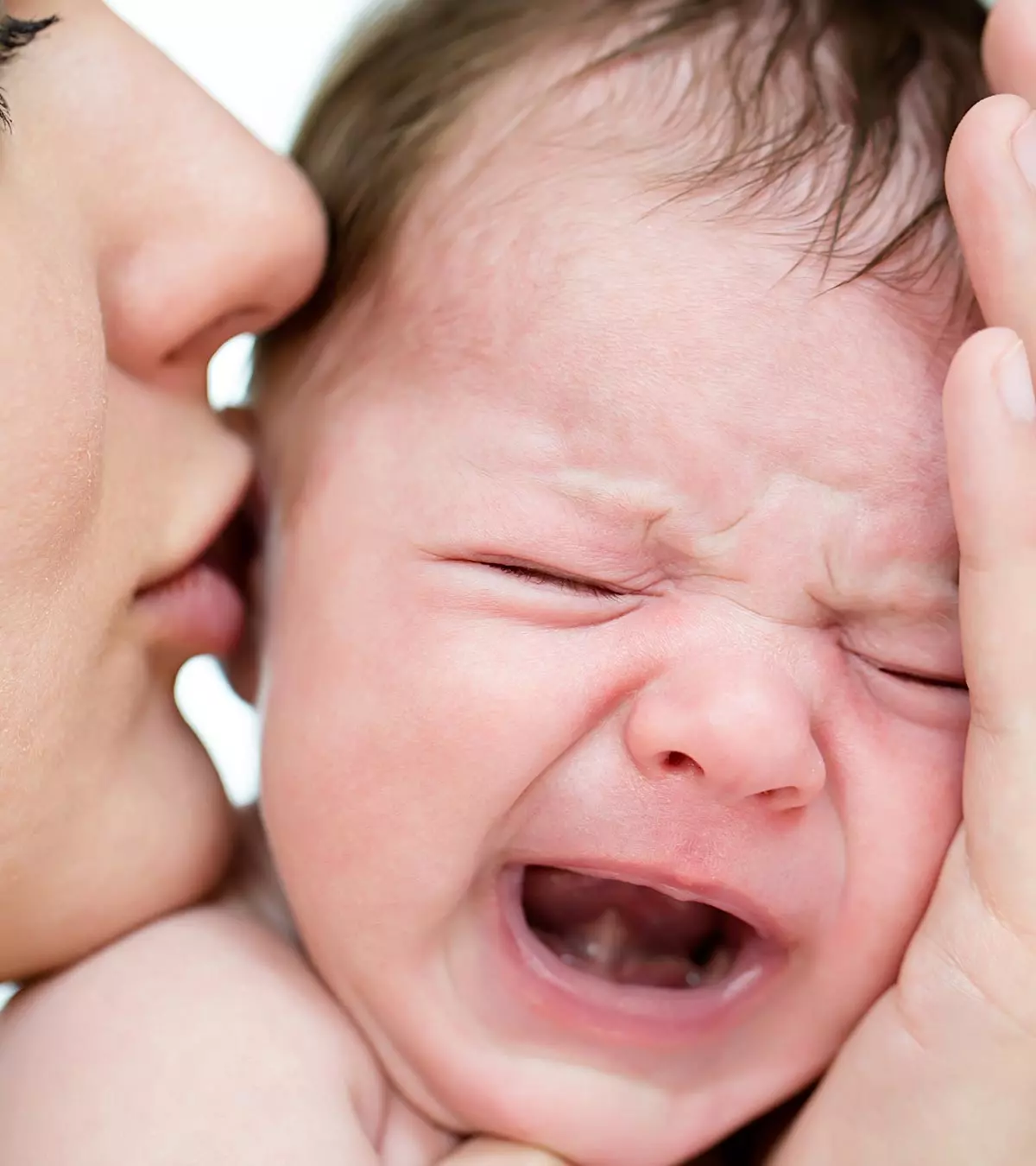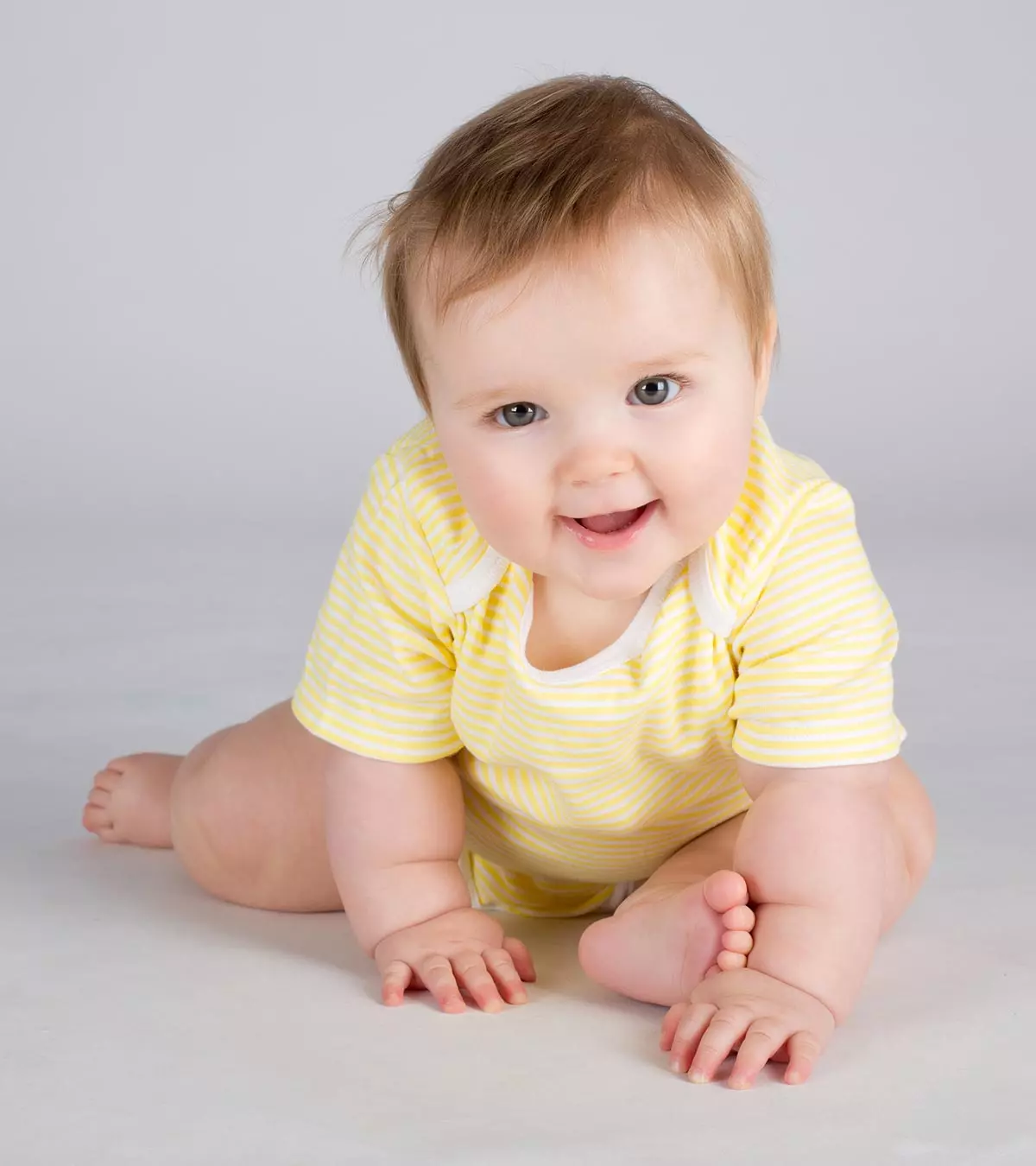
Image: ShutterStock
When you look at your 10-month-old baby’s development, you’ll realize that you are just a few months away from your baby’s first birthday. They have acquired their personalities by this age and have become skilled in so much. They have also developed intellectual abilities.

All of these abilities result from your baby reaching various developmental milestones. Understanding these milestones helps track growth and identify potential delays for timely support. This post discusses all of the important developmental milestones that occur at the age of ten months and their many variations.
Key Pointers
- At ten months, babies exhibit new milestones such as searching for hidden objects, associating meaning with words, and saying “mama” and “dada.”.
- Physical development milestones include crawling, using a pincer grasp, moving from tummy to sitting position, and pulling to stand.
- Social and emotional milestones include responding to scary or distressing situations, waving, and displaying stranger anxiety.
- Providing ample space, having meaningful conversations, and playing games such as peek-a-boo can enhance a baby’s development.
10-Month-Old Milestones Chart
| Achieved developmental milestones | Emerging developmental milestones |
|---|---|
| Crawls and pulls to stand | Walks with support (cruising) |
| Understands meaning of some words | Understands and speaks simple words |
| Moves from tummy to sitting position | Can sit up from standing position |
| Understands requests | Understands other basic instructions |
| Imitates basic actions | Repeats activities after observation |
| Searches for hidden objects | Remembers the location of objects by memory |
| Reacts to scary or distressing situations | Responds to more number of circumstances |
| Has pincer grasp | Can use full hand to hold objects |
| Improved depth perception | Better depth perception and hand-eye coordination |
| Has some teeth | Can have eight teeth by the first birthday |
10-Month-Old Baby Developmental Milestones
An infant achieves his developmental milestones in cognitive, physical, and social and emotional stages. Specific achievements in each category ensure the baby’s overall growth and development.
Cognitive Developmental Milestones

A 10-month-old’s cognitive developmental milestones comprise intelligence, brain development, and overall thinking prowess.
- Develops object permanence: The ability to recognize the existence of an object is referred to as object permanence. At ten months, the baby knows that a hidden object continues to exist and does not disappear (1). This ability makes him less anxious when a parent is not in the line of sight.
- Searches for hidden objects: Object permanence leads to inquisitiveness. A baby will find objects that are hidden or have moved out of his field of vision (2). For example, if a toy car slips under the sofa the baby will lean a bit to find it. If you hide a toy under the blanket, he will not stop looking for it unless he finds it.
 Quick tip
Quick tip- Enjoys looking at picture books: The 10-month-old will enjoy sitting in the parents’ lap and looking at image-rich books. He loves listening to stories and will visually absorb all the colorful illustrations. The infant’s brain is learning to better process the images and sounds, and picture books are a great help.
- Associates meaning with words: As part of the 10-month-old’s language development, he now understands the meaning of some basic words such as “hi”, “no”, “go”, and remembers the sounds of nouns such as the name of his favorite toy or food.
- Repeats actions: An essential attribute of a 10-month-old’s behavior is the ability to imitate actions. An infant forms a memory of an action and remembers the response to it. He then does the action to observe how others react to it.
- Says “mama” and “dada”: The infant now uses the correct nouns to address parents. He may not get it right with the correct parent, but it is nevertheless quite an achievement from the previous month.
- Understands request: Request the baby to hand over something, and he will slide it slowly into your hands. At ten months, the baby can discern requests, which is a significant social development milestone (3).
Physical Developmental Milestones

These milestones are an insight into a 10-month-old’s motor skills and principal physical development traits.
- Crawls well: A 10-month baby masters crawling, an essential part of growth and development. Watch as your little one completes exploring your house in no time.
Angela, a mother and a recipe blogger, reflects on her baby Adrianna’s crawling progress in her 10th month. She says, “Her fast army crawl is transitioning into a full out crawl this month. It’s so cute watching her put the pieces together as she learns new skills. She was doing all these planks and downward dogs one week, and this week she’s all about getting into the crawl position and raising her arms up to grab things (i).”
- Uses pincer grasp: A grasping ability that uses the index finger and the thumb to pick small objects (4). The essential physical development facilitates the introduction of finger foods.
- Moves from tummy to sitting position: When the baby is bored of tummy time, he will roll into the sitting position. Stronger back and abdomen muscles help with this.
- Pulls to stand: Standing is the first step towards walking and eventually running. And, by the end of nine months, an infant may pull himself up to a standing position while using an object for support (5).
- May move forward while standing: Once on his feet, the baby may make his first attempt to walk by moving a foot forward, while holding on to support. Eventually, he walks, taking the support of one object after another. This is called cruising.
- Can have all central incisors: The two lower central incisors erupt at eight months, and the pair on the upper jaw may emerge by ten months (6). It coincides with the phase when the baby is ready for finger foods and makes biting convenient.
- Improved visual depth perception: Eyes develop constantly, and by 10 months, the baby will have an enhanced depth perception with better hand-eye coordination (7). Activities such as crawling and pulling to stand further boost visual development.
Social And Emotional Developmental Milestones
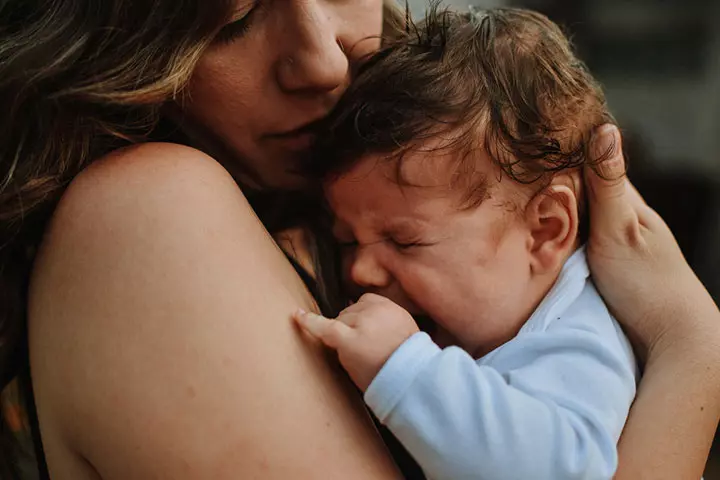
Here’s when your baby is preparing for all the social gatherings and emotional temperament.
- Waves goodbye: Seeing off the baby now has its special moments. 10-month-olds learn to wave goodbye and develop an understanding of this social gesture. They may even chirp something that sounds like “bye-bye”.
- Stranger anxiety: A baby may not be comfortable in the company of strangers or if left alone with them. He may resist going into their arms.
- Separation anxiety: According to the American Academy of Pediatrics, babies develop heightened separation anxiety after ten months (8). The baby may clutch onto the caretaker and even throw tantrums to prevent them from leaving.
 Quick tip
Quick tip- Reacts to situations: The baby will cry if you take away a toy from him. He may be nervous, if he hears a loud noise. Your baby will now have a wider range of reactions.
- Enjoy playing hide-and-seek: Babies achieve various skills at different ages. While some babies pick up those skills faster, some may take a little more time. So worry not! But, at the same time, be on the lookout for roadblocks!
When To Be Concerned?

You must watch for the following signs of delayed development in a 10-month-old:
- Does not crawl: Babies crawl effortlessly by 10 months, and if an infant is unable to do so then it could be a sign of developmental delay.
- Makes no sounds: A 10-month-old may not speak but will make an array of sounds and noises. If the baby is unusually quiet, then you must take him to a doctor.
- Cannot stand with support: The baby is now capable of pulling himself into a standing position with support. If he fails to do this, then it indicates a developmental delay. Pulling to stand is important as it lays the foundation for walking skills.
- Fails to recognize familiar people: If your baby is not recognizing known individuals and everyday objects, then it could indicate a cognitive trouble or a problem with the baby’s vision.
If you spot any of these signs, then do not panic. Instead, take your baby to a pediatrician and let the medical professional make the assessment. The American Academy of Paediatrics recommends getting your baby checked by a doctor periodically for a timely detection of any developmental delay (9).
A medical check-up combined with a little care and caution, can go a long way in ensuring the baby’s smooth development.
Tips To Improve 10-Month-Old Baby’s Development

There are some simple and easy ways to stimulate your 10-month-old’s development and ensure that his growth stays right on track:
- Provide ample crawling space: It is time to move that furniture and roll out the rug. Your baby would love to crawl and the more he crawls, the better his muscles prepare for important activities such as walking. Give your baby adequate space to exercise his crawling skills. Baby proof the house to ensure maximum safety.
- Assist pull to stand: Get your baby a push car that is heavy enough to support the baby’s weight. The infant can pull to stand with the help of the car. The baby may, however, take a few steps in case the car is wheeled and moves easily. The American Academy of Paediatrics recommends toy push cars and stationary walkers. They, however, advise against the use of baby walkers (10).
- Have meaningful conversations: It is time to cut down on that baby talk a bit and have some useful chat. Babies at ten months understand words such as “no” and “go”. The more new words you introduce in the little one’s vocabulary, the better is his vocabulary.
 Point to consider
Point to consider- Play games that nurture: Have an activity schedule where you play games that improve various growth milestones. Introduce activities for 10-month-old babies that promote socialization to help reduce the baby’s separation anxiety and fear of strangers.
- Try new finger foods: Introduce new finger foods to the baby and let him eat by himself. Show the little one how to grip the food and the correct way to eat it, and then let him be. Eating finger foods by himself helps in making baby-led weaning easier by the first birthday.
Angela recounts her experience with baby-led weaning (BLW) with her daughter Adrianna. She writes, “When she was around 7-8 months, we tried Baby Led Weaning, but she didn’t show any interest and she had a really bad gag reflex so that freaked us out a bit. So we stuck with purees, but she never showed much interest in them at all. She didn’t seem to like being spoon fed and always tried to whip the spoon out of our hand, hah. So at around 9 months, I decided to give BLW another shot.
“For the first week, she still gagged a lot (not the same as choking, as I learned) and she still seemed on the fence with this whole eating business. But after a week or so, she started to get SO excited when we fed her and the gagging virtually stopped. Now after about 4 weeks of doing BLW (3 times a day) she has done a complete 180 with her eating. We give her everything from steamed vegetables to avocado to tofu to our own meals (such as lentil stew or quinoa salad) and I don’t hold back with adding flavor with spices like cumin, paprika, etc.”
Frequently Asked Questions
1. What weight should a 10-month-old baby be?
The rate of weight gain for babies can vary greatly and is influenced by factors such as genetics, feeding practices, and overall health. While it is a general guideline that a baby’s birth weight may double by five months and triple by one year, these milestones are just averages and not a hard rule for all babies (11).
2. How many teeth should a 10-month-old have?
A 10-month-old baby may have, on average, about 4-6 teeth (12)
3. How many words can a 10-month-old baby speak?
A 10-month-old baby may be able to say words like “mama” or “dada.” However, most babies learn to say 1-2 words by the time they reach 15 months (13).
4. What is the 10-month-old baby’s sleep duration and pattern?
Around this stage, your baby’s sleep patterns align more with those of adults, resulting in fewer nighttime awakenings. While some babies may sleep through the night, others might still need assistance 3–4 times (14). On average, babies at this age sleep for 12–16 hours daily, with a substantial 9–12 hours during the night, crucial for their health and growth (15). Most infants also take 2–3 daytime naps, lasting anywhere from 30 minutes to 2 hours each (16).
5. What can I include in my 10-month-old baby food?
Introduce solid foods, such as homemade options like finely ground meats, soft bread, or whole rice. Ensure the textures are small and mushy to avoid choking. You can also offer cereal softened with water, breast milk, or formula (17). Provide a balanced diet with iron-rich foods, fruits, vegetables, and healthy fats. Begin with a trial of each new food, introducing one at a time, and wait a few days to a week to monitor for potential allergic reactions.
It is exciting to assess your 10-month-old baby’s development through the milestones they have achieved. Your baby will crawl, try to stand, and roll from tummy to sitting position by this age. Their language abilities have progressed substantially from the early stages of communication, characterized by babbling and pointing, to now being able to address you as mama or dada. They will also display stranger anxiety, wave goodbye, and love playing hide and seek. You may further improve their skills by playing games and communicating with them. If your child did not achieve some of these milestones, do not worry since each child is unique and will achieve them gradually. However, you should talk to a professional if your child is way beyond age and has not started crawling, recognizing people, or making sounds. Timely diagnosis and treatment of developmental delays can help manage them efficiently.
Infographic: Developmental Milestones Of A 10-Month-Old Baby
During the first year of life, babies grow and develop at a quick pace. With each passing month, you can observe them pick up various skills. We present the following infographic with the developmental milestones of a 10-month-old, helping you better acquaint yourself with the skills of your little one at this age.
Some thing wrong with infographic shortcode. please verify shortcode syntaxIllustration: Month-Old Baby: Development Milestones And Growth
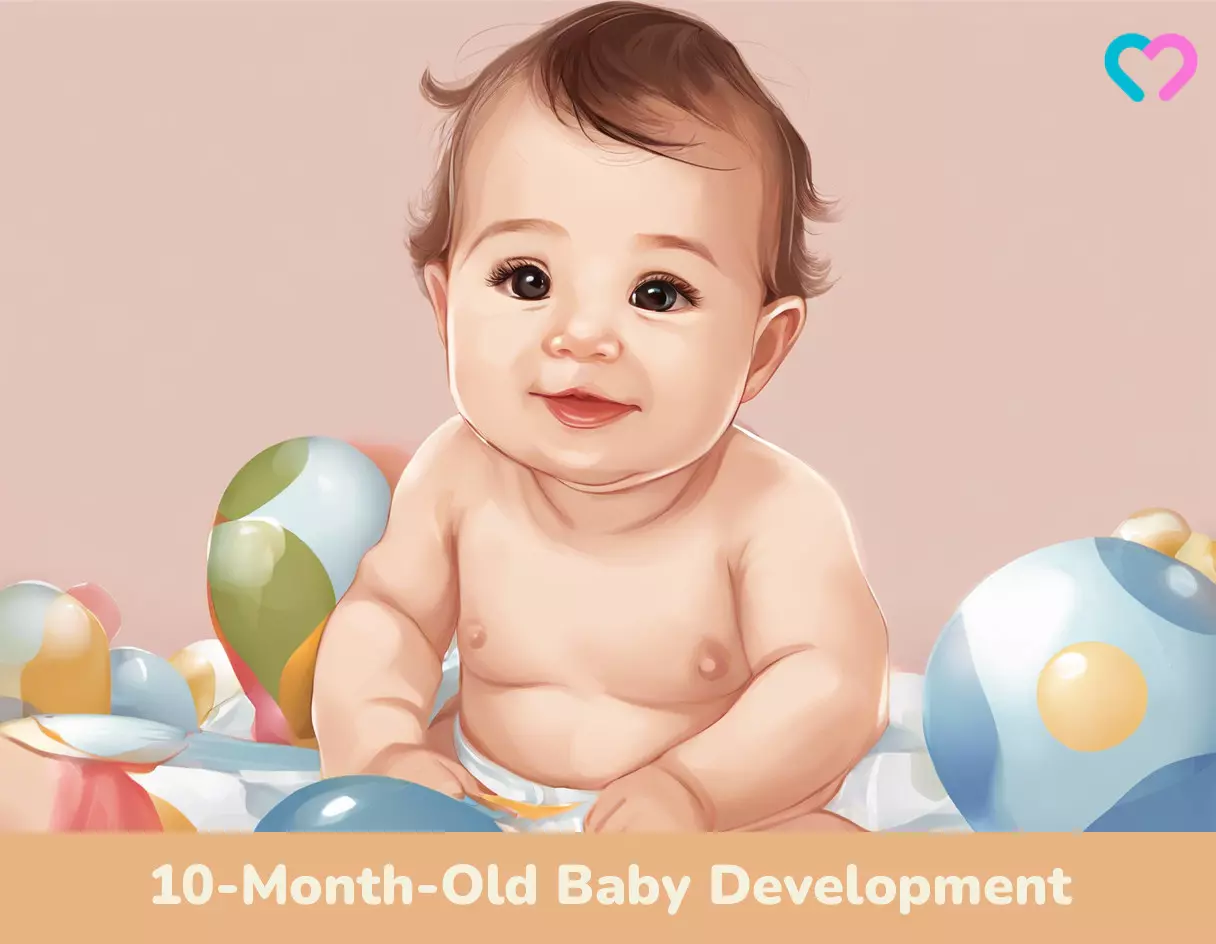
Image: Stable Diffusion/MomJunction Design Team
Witness the miraculous growth and development of your baby during the 8-10 month stage. Discover invaluable guidance from professionals in this video on how to support your little ones in reaching their milestones.
Personal Experience: Source
MomJunction articles include first-hand experiences to provide you with better insights through real-life narratives. Here are the sources of personal accounts referenced in this article.
i. Life With A Baby: 10 Months.https://ohsheglows.com/life-with-a-baby-10-months/
References
- First Year Infant Development.
https://americanpregnancy.org/healthy-pregnancy/first-year-of-life/first-year-infant-development/ - Cognitive Development: 8 to 12 Months.
https://www.healthychildren.org/English/ages-stages/baby/Pages/Cognitive-Development-8-to-12-Months.aspx - Developmental Milestones: Fine Motor Skills and Visual Motor Skills.
https://www.choc.org/userfiles/file/Rehab-Developmental%20Milestones%20final.pdf - Finger to Thumb: What To Know About the Pincer Grasp.
https://health.clevelandclinic.org/pincer-grasp - Infant – newborn development.
https://medlineplus.gov/ency/article/002004.htm - Baby’s First Tooth: 7 Facts Parents Should Know.
https://www.healthychildren.org/English/ages-stages/baby/teething-tooth-care/Pages/Babys-First-Tooth-Facts-Parents-Should-Know.aspx - Infant Vision: Birth to 24 Months of Age.
https://www.aoa.org/healthy-eyes/eye-health-for-life/infant-vision?sso=y - Social Development: 2 Year Olds.
https://www.healthychildren.org/English/ages-stages/toddler/Pages/Social-Development-2-Year-Olds.aspx - Important Milestones: Your Baby By Nine Months.
https://www.cdc.gov/ncbddd/actearly/milestones/milestones-9mo.html - Movement: Babies 8 to 12 Months.
https://www.healthychildren.org/English/ages-stages/baby/Pages/Movement-8-to-12-Months.aspx - Developmental Milestones: 10 to 12 Month Baby.
https://choc.org/primary-care/ages-stages/10-to-12-months/ - Dental: Teeth and Gum Care for Infants and Toddlers.
https://www.nationwidechildrens.org/family-resources-education/health-wellness-and-safety-resources/helping-hands/dental-teeth-and-gum-care-for-infants-and-toddlers - Communication and Your 1-to 2-Year Old.
https://kidshealth.org/en/parents/c12yr.html - Baby sleep: 2-12 months.
https://raisingchildren.net.au/babies/sleep/understanding-sleep/sleep-2-12-months - Sleep in Your Baby’s First Year.
https://my.clevelandclinic.org/health/articles/14300-sleep-in-your-babys-first-year - Developmental Milestones:10 to 12 Month Baby.
https://choc.org/primary-care/ages-stages/10-to-12-months/ - 10-11 months: baby development.
https://raisingchildren.net.au/babies/development/development-tracker-3-12-months/10-11-months
Community Experiences
Join the conversation and become a part of our nurturing community! Share your stories, experiences, and insights to connect with fellow parents.
Read full bio of Dr. Saroj Kumar
Read full bio of Rohit Garoo
Read full bio of Dr. Ritika Shah
Read full bio of Vibha Navarathna






